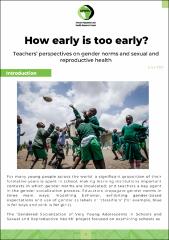| dc.contributor.author | Maina, Beatrice | |
| dc.contributor.author | Mbuthia, Michelle | |
| dc.contributor.author | Bangha, Martin | |
| dc.date.accessioned | 2023-08-28T13:56:37Z | |
| dc.date.available | 2023-08-28T13:56:37Z | |
| dc.date.issued | 2022-05 | |
| dc.identifier.uri | http://10.176.203.77/handle/123456789/271 | |
| dc.description.abstract | For many young people across the world
a significant proportion of theirformative years is spent in school, making learning institutions importantcontexts in which gender norms are inculcated; and teachers a key agentin the gender socialization process. Educators propagate gender norms inthree main ways: modelling behavior, exhibiting gender-basedexpectations and use of gender as labels or ‘classifiers’ (for example, blueis for boys and pink is for girls). | en_US |
| dc.language.iso | en | en_US |
| dc.publisher | APHRC | en_US |
| dc.subject | Population Dynamics and Reproductive Health | en_US |
| dc.subject | Sexual and Reproductive Health | en_US |
| dc.subject | Adolescent | en_US |
| dc.subject | Gender Norms | en_US |
| dc.subject | Reproductive Health Education | en_US |
| dc.title | How early is too early? Teachers’ Perspectives on Gender Norms and Sexual and Reproductive Health | en_US |
| dc.type | Working Paper | en_US |

